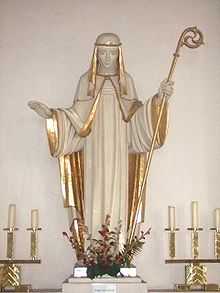Irmgard of Chiemsee
| Blessed Irmgard of Chiemsee | |
|---|---|
 Statue of Irmgard in the Collegiate Church of Buchau | |
| Born |
c. 830/833 Regensburg |
| Died |
16 July 866 Frauenchiemsee |
| Venerated in | Roman Catholic Church |
| Beatified | 1928 by Pius XI |
| Feast | 16 July |
| Attributes | crowned, in Benedictine abbess's habit, holding abbot's staff |
Irmgard (or Ermengard) of Chiemsee (c. 830/833, Regensburg – 16 July 866, Frauenchiemsee) was a daughter Louis the German, King of East Francia, and his wife Hemma. She was the first Abbess of Chiemsee from 857.[1] During her leadership the chapter for noble ladies developed into a Benedictine convent. Since she was of imperial descendance, the incumbent Abbess of Chiemssee had the right to wear a thin golden hoop, resembling a little crown, ever since. Modern-era Abbesses, however, refrain from doing so.
Irmgard's cult was officially recognised only in 1928 by Pope Pius XI. Her feast day is 16 July.[2] In Frauenchiemsee, Irmengardstag is celebrated the Sunday nearest to 16 July. In paintings Irmgard is portrayed in a Benedictine habit either crowned with Bible and abbot's staff or with heart in her hand.
Ancestry
| Ancestors of Irmgard of Chiemsee | |||||||||||||||||||||||||||||||||||||||||||||||||||||||||||||||||||||||||||||||||||||||||||||||||||||||||||||||||||||||||||||||||||||||||||||||||||||||||||||||||||||||||||||||||||||||||||||||||||||||||||||||||||||||||||||||||||||||||||||||||||||||||||||||||||||||||||||||||||||||||||||||||||||||||||||||||||||||||||||||||||||
|---|---|---|---|---|---|---|---|---|---|---|---|---|---|---|---|---|---|---|---|---|---|---|---|---|---|---|---|---|---|---|---|---|---|---|---|---|---|---|---|---|---|---|---|---|---|---|---|---|---|---|---|---|---|---|---|---|---|---|---|---|---|---|---|---|---|---|---|---|---|---|---|---|---|---|---|---|---|---|---|---|---|---|---|---|---|---|---|---|---|---|---|---|---|---|---|---|---|---|---|---|---|---|---|---|---|---|---|---|---|---|---|---|---|---|---|---|---|---|---|---|---|---|---|---|---|---|---|---|---|---|---|---|---|---|---|---|---|---|---|---|---|---|---|---|---|---|---|---|---|---|---|---|---|---|---|---|---|---|---|---|---|---|---|---|---|---|---|---|---|---|---|---|---|---|---|---|---|---|---|---|---|---|---|---|---|---|---|---|---|---|---|---|---|---|---|---|---|---|---|---|---|---|---|---|---|---|---|---|---|---|---|---|---|---|---|---|---|---|---|---|---|---|---|---|---|---|---|---|---|---|---|---|---|---|---|---|---|---|---|---|---|---|---|---|---|---|---|---|---|---|---|---|---|---|---|---|---|---|---|---|---|---|---|---|---|---|---|---|---|---|---|---|---|---|---|---|---|---|---|---|---|---|---|---|---|---|---|---|---|---|---|---|---|---|---|---|---|---|---|---|---|---|---|---|---|---|---|---|---|---|---|---|---|---|---|---|---|---|---|---|---|---|---|---|---|
| |||||||||||||||||||||||||||||||||||||||||||||||||||||||||||||||||||||||||||||||||||||||||||||||||||||||||||||||||||||||||||||||||||||||||||||||||||||||||||||||||||||||||||||||||||||||||||||||||||||||||||||||||||||||||||||||||||||||||||||||||||||||||||||||||||||||||||||||||||||||||||||||||||||||||||||||||||||||||||||||||||||
Notes
- ↑ "Frauenwörth". Monasticon: repertory of profiles of women's religious communities that existed between 400-1600 C.E. Monastic Matrix hosted by University of Southern California. Retrieved 2007-11-16.
- ↑ Rabenstein, Katherine I. (1998). "Saints of 16 July". Saints O'the Day. St. Patrick Catholic Church Washington, D.C. Archived from the original on 2007-11-05. Retrieved 2007-11-16.
References
- "Selige Irmengard". Frauenwörth (in German). Abtei Frauenwörth. Archived from the original on 2007-10-10. Retrieved 2007-11-16.